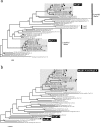Recurrent adenylation domain replacement in the microcystin synthetase gene cluster
- PMID: 17908306
- PMCID: PMC2174460
- DOI: 10.1186/1471-2148-7-183
Recurrent adenylation domain replacement in the microcystin synthetase gene cluster
Abstract
Background: Microcystins are small cyclic heptapeptide toxins produced by a range of distantly related cyanobacteria. Microcystins are synthesized on large NRPS-PKS enzyme complexes. Many structural variants of microcystins are produced simultaneously. A recombination event between the first module of mcyB (mcyB1) and mcyC in the microcystin synthetase gene cluster is linked to the simultaneous production of microcystin variants in strains of the genus Microcystis.
Results: Here we undertook a phylogenetic study to investigate the order and timing of recombination between the mcyB1 and mcyC genes in a diverse selection of microcystin producing cyanobacteria. Our results provide support for complex evolutionary processes taking place at the mcyB1 and mcyC adenylation domains which recognize and activate the amino acids found at X and Z positions. We find evidence for recent recombination between mcyB1 and mcyC in strains of the genera Anabaena, Microcystis, and Hapalosiphon. We also find clear evidence for independent adenylation domain conversion of mcyB1 by unrelated peptide synthetase modules in strains of the genera Nostoc and Microcystis. The recombination events replace only the adenylation domain in each case and the condensation domains of mcyB1 and mcyC are not transferred together with the adenylation domain. Our findings demonstrate that the mcyB1 and mcyC adenylation domains are recombination hotspots in the microcystin synthetase gene cluster.
Conclusion: Recombination is thought to be one of the main mechanisms driving the diversification of NRPSs. However, there is very little information on how recombination takes place in nature. This study demonstrates that functional peptide synthetases are created in nature through transfer of adenylation domains without the concomitant transfer of condensation domains.
Figures







References
-
- Sivonen K, Jones G. Cyanobacterial toxins. In: Chorus I, Bartram J, editor. Toxic cyanobacteria in water. London, E&FN Spon; 1999. pp. 41–111.
Publication types
MeSH terms
Substances
LinkOut - more resources
Full Text Sources
Molecular Biology Databases
Miscellaneous

